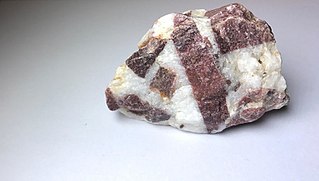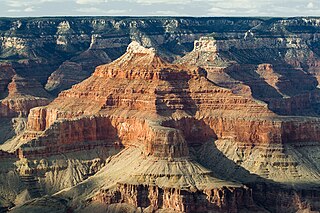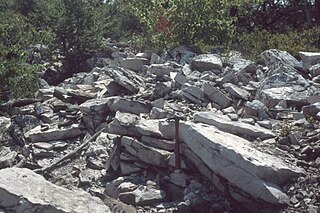 W
WQuartzite is a hard, non-foliated metamorphic rock which was originally pure quartz sandstone. Sandstone is converted into quartzite through heating and pressure usually related to tectonic compression within orogenic belts. Pure quartzite is usually white to grey, though quartzites often occur in various shades of pink and red due to varying amounts of hematite. Other colors, such as yellow, green, blue and orange, are due to other minerals.
 W
WBaraboo Quartzite is a Precambrian geological formation of quartzite, found in the region of Baraboo, Wisconsin. While pure quartzite is usually white or gray, Baraboo Quartzite is typically dark purple to maroon in color, due to the presence of iron (hematite) and other impurities. Baraboo Quartzite may display strata created by progressive deposition of layers of sand in the original sandstone from which the quartzite was formed. Specimens of Baraboo quartzite may also display ripple marks that appear visually similar to the patterns one might see in the sand at a beach. Ripples indicate that the sandstone from which the quartzite was metamorphosed was originally water-laid sediment.
 W
WBig Rock is a 16,500-tonne (18,200-ton) boulder that lies on the otherwise flat, relatively featureless, surface of the Canadian Prairies in Alberta. It is part of the 930-kilometre-long (580 mi) Foothills Erratics Train of typically angular boulders of distinctive quartzite and pebbly quartzite.
 W
WChampe Rocks are a pair of large crags in Pendleton County in the Eastern Panhandle of West Virginia, USA. Easily visible from West Virginia Route 28, they are situated within the Spruce Knob-Seneca Rocks National Recreation Area. They are — along with the nearby and more celebrated Seneca Rocks — the most imposing examples in eastern West Virginia of several formations of the white/gray Tuscarora quartzite and are a popular challenge for rock climbers.
 W
WThe Cambrian Chickies Formation is a mapped bedrock unit in Pennsylvania, New Jersey, and Maryland. It is named for Chickies Rock, north of Columbia, Pennsylvania along the Susquehanna River.
 W
WThe Mesoproterozoic Dripping Spring Quartzite is a resistant, purple quartzite formation found in central and southeast Arizona, USA. It is a cliff-forming purplish unit found in the lower sections of the Apache Group, units of originally sedimentary layers, but later metamorphosed. The Apache Group is coeval with a similar aged Proterozoic sequence of eight geologic units found in the lowest geologic sequences of the Grand Canyon, the Grand Canyon Supergroup.
 W
WThe Foothills Erratics Train is a 580 miles (930 km) long, narrow, linear scatter of thousands of typically angular boulders of distinctive quartzite and pebbly quartzite that lie on the surface of a generally north-south strip of the Canadian Prairies. These boulders, which are between 1 foot (0.30 m) and 135 feet (41 m) in length, are glacial erratics that lie upon a surficial blanket of Late Wisconsin glacial till. The largest glacial erratic within the Foothills Erratics Train is Big Rock.
 W
WThe Letná Formation is a Late Ordovician geologic formation of the Prague Basin, Bohemian Massif in the Czech Republic. The formation crops out in the Czech capital, more specifically at Letná Hill, after which the formation is named. The type locality is located at Malá Strana, Holešovice district.
 W
WMonte Binga is the highest mountain in Mozambique and the second highest mountain in Zimbabwe. It is located in the Chimanimani Mountains, on the border between Zimbabwe and Mozambique in the Chimanimani Transfrontier Park in Manica Province. Its height is 8004 feet (2440m) above sea level
 W
WNelson Rocks is a large privately owned rock formation located in the North Fork Valley of Pendleton County, West Virginia, United States. The area is operated under the name of NROCKS Outdoor Adventures, and was previously known as Nelson Rocks Outdoor Center (NROC).
 W
WNorth Stack is a small island situated just off Holy Island on the north-west coast of Anglesey.
 W
WOakley stone is the trade name of a building stone that occurs in the mountains of southern Idaho in the western United States. It is more properly known as Rocky Mountain quartzite or Idaho quartzite, a metamorphic rock. The stone is quarried south of the city of Oakley in Cassia County, northeast of the three-state border with Nevada & Utah. The quarries are located on the west slope of Middle Mountain in the Albion Mountains, northwest of the City of Rocks National Reserve.
 W
WPoint of Rocks is a geologically significant outcropping located along U.S. Route 12 (US 12) in the Town of Baraboo in Sauk County, Wisconsin, United States, southwest of the city of Baraboo. The formation is made up of Baraboo Quartzite and is part of the Baraboo Range; it dates from the Precambrian and is roughly 1.7 billion years old. Along with the nearby Van Hise Rock, the formation was instrumental in the University of Wisconsin–Madison's development of the field of geology in the late 19th and early 20th centuries. The formation is listed on the National Register of Historic Places.
 W
WSeneca Rocks is a large crag and local landmark in Pendleton County in the Eastern Panhandle of West Virginia, United States. The south peak is one of a small number of peaks inaccessible except by technical rock climbing techniques on the East Coast of the United States. One of the best-known scenic attractions in West Virginia, the sheer rock faces are a popular challenge for rock climbers.
 W
WThe Shinumo Quartzite also known as the Shinumo Sandstone, is a Mesoproterozoic rock formation, which outcrops in the eastern Grand Canyon, Coconino County, Arizona. It is the 3rd member of the 5-unit Unkar Group. The Shinumo Quartzite consists of a series of massive, cliff-forming sandstones and sedimentary quartzites. Its cliffs contrast sharply with the stair-stepped topography of typically brightly-colored strata of the underlying Hakatai Shale. Overlying the Shinumo, dark green to black, fissile, slope-forming shales of the Dox Formation create a well-defined notch. It and other formations of the Unkar Group occur as isolated fault-bound remnants along the main stem of the Colorado River and its tributaries in Grand Canyon. Typically, the Shinumo Quartzite and associated strata of the Unkar Group dip northeast (10°-30°) toward normal faults that dip 60+° toward the southwest. This can be seen at the Palisades fault in the eastern part of the main Unkar Group outcrop area.
 W
WThe Sioux Quartzite is a Proterozoic quartzite that is found in the region around the intersection of Minnesota, South Dakota, and Iowa, and correlates with other rock units throughout the upper midwestern and southwestern United States. It was formed by braided river deposits, and its correlative units are thought to possibly define a large sedimentary wedge that once covered the passive margin on the then-southern side of the North American craton. In human history, it provided the catlinite, or pipestone, that was used by the Plains Indians to carve ceremonial pipes. With the arrival of Europeans, it was heavily quarried for building stone, and was used in many prominent structures in Sioux Falls, South Dakota and shipped to construction sites around the Midwest. Sioux Quartzite has been and continues to be quarried in Jasper, Minnesota at the Jasper Stone Company and Quarry, which itself was posted to the National Register of Historic Places on January 5, 1978. Jasper, Minnesota contains many turn-of-the-century quartzite buildings, including the school, churches and several other public and private structures, mostly abandoned.
 W
WSteptoe Butte is a quartzite island jutting out of the silty loess of the Palouse hills in Whitman County, Washington, in the northwest United States. The 3,612-foot (1,101 m) butte is preserved as Steptoe Butte State Park, a publicly owned 150-acre (61 ha) recreation area located 12 miles (19 km) north of Colfax. Steptoe Butte and Kamiak Butte comprise Steptoe and Kamiak Buttes National Natural Landmark.
 W
WThe Stiperstones is a distinctive hill in the county of Shropshire, England. The quartzite rock of the ridge formed some 480 million years ago. During the last Ice Age Stiperstones lay on the eastern margin of the Welsh ice sheet. The hill itself was not glaciated though glaciers occupied surrounding valleys and it was subject to intense freezing and thawing which shattered the quartzite into a mass of jumbled scree surrounding several residual rocky tors. At 536 metres (1,759 ft) above sea level it is the second-highest hill in the county, surpassed only by Brown Clee Hill. Stiperstones' 8-kilometre (5 mi) summit ridge is crowned by several jagged outcrops of rock, which may be seen silhouetted against the sky.
 W
WThe Silurian Tuscarora Formation — also known as Tuscarora Sandstone or Tuscarora Quartzite — is a mapped bedrock unit in Pennsylvania, Maryland, West Virginia, and Virginia, USA.
 W
WVan Hise Rock is a rock monolith located along Wisconsin Highway 136 near Rock Springs, Wisconsin. The rock is a geologically significant outcropping of Baraboo Quartzite.
 W
WWulingyuan is a scenic and historical site in the Wulingyuan District of South Central China's Hunan Province. It was inscribed as a UNESCO World Heritage Site in 1992. It is noted for more than 3,000 quartzite sandstone pillars and peaks across most of the site, many over 200 metres (660 ft) in height, along with many ravines and gorges with attractive streams, pools, lakes, rivers and waterfalls. It features 40 caves, many with large calcite deposits, and a natural bridge named Tianqiashengkong, which is one of the highest natural bridges in the world.